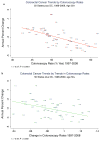Changes in colorectal cancer incidence rates in young and older adults in the United States: what does it tell us about screening
- PMID: 24249437
- PMCID: PMC4394895
- DOI: 10.1007/s10552-013-0321-y
Changes in colorectal cancer incidence rates in young and older adults in the United States: what does it tell us about screening
Abstract
Purpose: Colorectal cancer (CRC) incidence rates have increased among young adults and have decreased among older adults. We re-evaluated these trends using more recent data covering about 96 % of the United States population.
Methods: Colorectal cancer incidence rates were abstracted from the National Program of Cancer Registries and the Surveillance Epidemiology and End Results analytic files for diagnosis years 1998-2009. We report rates for young adults (age <50 years) and for older adults (age 50 years or older) by four race/ethnicity groupings. We examined CRC incidence rates by stage at diagnosis, tumor subsite, and state. We calculated the correlation between state-specific CRC incidence and prevalence of colonoscopy reported in the Behavioral Risk Factor Surveillance System.
Results: Rectal cancer incidence rates increased from 1998 through 2009 among young non-Hispanic white adults and young blacks. Among older adults, CRC incidence rates decreased among all four race/ethnicity groupings and in all states. The decline was apparent for all stages and for all subsites. States with greater decreases in CRC incidence rates had higher colonoscopy screening rates.
Conclusion: Rectal cancer is increasing among younger adults, for reasons largely unknown. Among older adults, CRC incidence continues to decrease, probably because of increasing uptake of colonoscopy screening. Decreases in CRC incidence are correlated with increased use of colonoscopy, indicating that CRC may be largely preventable through colonoscopy screening. Efforts to increase screening rates in underserved populations would help reduce health disparities associated with this type of cancer.
Conflict of interest statement
Figures




References
-
- U.S. Preventive Services Task Force. Screening for colorectal cancer. Recommendation statement. 2008 Oct; www.uspreventiveservicestaskforce.org.
-
- Siegel RL, Ward EM, Jemal A. Trends in colorectal cancer incidence rates in the United States by tumor location and stage, 1992–2008. Cancer Epidemiol Biomarkers Prev. 2012;21:411–416. - PubMed
-
- Siegel RL, Jemal A, Ward EM. Increase in incidence of colorectal cancer among young men and women in the United States. Cancer Epidemiol Biomarkers Prev. 2009;18:1695–1698. - PubMed
-
- Surveillance Research Program, National Cancer Institute. SEER*Stat software version 7.0.5. Available at: seer.cancer.gov/seerstat.
-
- National Program of Cancer Registries, United States Cancer Statistic, Centers for Disease Control and Prevention. [Accessed 14 Feb 2012];2012 Available at http://www.cdc.gov/cancer/npcr/uscs/technical_notes/criteria.htm/
MeSH terms
Grants and funding
LinkOut - more resources
Full Text Sources
Other Literature Sources
Medical

